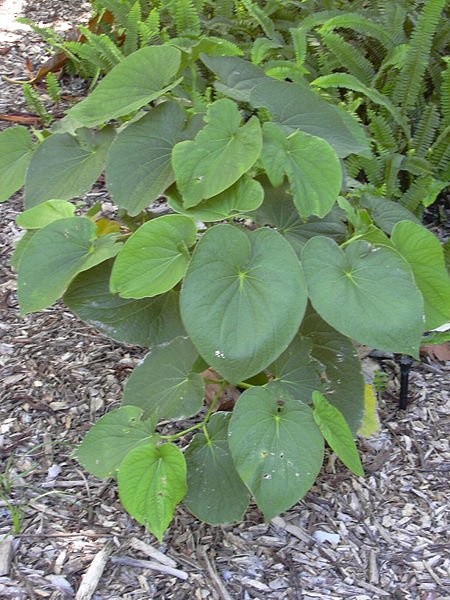The word kava is used to refer both to the plant and the beverage produced from its roots. Kava is a tranquilizer primarily consumed to relax without disrupting mental clarity. Its active ingredients are called kavalactones. In some parts of the Western World, kava extract is marketed as herbal medicine against stress, insomnia, and anxiety. A Cochrane Collaboration systematic review of its evidence concluded that it was likely to be more effective than placebo at treating short-term social anxiety. Safety concerns have been raised over liver toxicity, although research indicates that this may be largely due to the use of stems and leaves in supplements, which were not used indigenously.

The extract is an emulsion of kavalactone droplets in starch. The taste is slightly pungent, while the distinctive aroma depends on whether it was prepared from dry or fresh plant, and on the variety. The colour is grey to tan to opaque greenish.
Kava prepared as described above is much more potent than processed kava. Chewing produces the strongest effect because it produces the finest particles. Fresh, undried kava produces a stronger beverage than dry kava. The strength also depends on the species and techniques of cultivation. Many find mixing powdered kava with hot water makes the drink stronger. However the active ingredients of kava, such as Kavalactone, are ruined at 140 degrees. Most tea steeps at 180 degrees for at least a couple minutes which will reduce the potency of the kava.
In Vanuatu, a strong kava drink is normally followed by a hot meal or tea. The meal traditionally follows some time after the drink so that the psychoactives are absorbed into the bloodstream quicker. Traditionally no flavoring is added.
Fijians commonly share a drink called 'grog', made by pounding sun-dried kava root into a fine powder and mixing it with cold water. Traditionally, grog is drunk from the shorn half-shell of a coconut, called a 'bilo'. Despite tasting very much like dirty water, grog is very popular in Fiji, especially among young men, and often brings people together for storytelling and socializing.
A moderately potent kava drink causes effects within 20–30 minutes that last for about two and a half hours, but can be felt for up to eight hours. Because of this, it is recommended to space out servings about fifteen minutes apart. Some report longer term effects up to two days after ingestion, including mental clarity, patience, and an ease of acceptance. The effects of kava are most often compared to alcohol, or a large dose of Valium.
The sensations, in order of appearance, are slight tongue and lip numbing (the lips and skin surrounding may appear unusually pale); mildly talkative and sociable behavior; clear thinking; anxiolytic (calming) effects; relaxed muscles; and a very euphoric sense of well-being. The numbing of the mouth is caused by the two kavalactones kavain and dihydrokavain which cause the contraction of the blood vessels in these areas acting as a local topical anesthetic. These anesthetics can also make one's stomach feel numb. Sometimes this feeling has been mistaken for nausea. Some report that caffeine, consumed in moderation in conjunction with kava can significantly increase mental alertness.
A potent drink results in a faster onset with a lack of stimulation; the user's eyes become sensitive to light, they soon become somnolent and then have deep, dreamless sleep within 30 minutes. Sleep is often restful and there are pronounced periods of sleepiness correlating to the amount and potency of kava consumed. Unlike with alcohol-induced sleep, after wakening the drinker does not experience any mental or physical after effects. However, this sleep has been reported as extremely restful and the user often wakes up more stimulated than he or she normally would (though excessive consumption of exceptionally potent brew has been known to cause pronounced sleepiness into the next day). Although heavy doses can cause deep dreamless sleep, it is reported that many people experience lighter sleep and rather vivid dreams after drinking moderate amounts of kava.
After thousands of years of use by the Polynesians and decades of research in Europe and the U.S., the traditional use of kava root has never been found to have any addictive or permanent adverse effects. Users do not develop a tolerance. While small doses of kava have been shown to slightly improve memory and cognition, large amounts at one time have been shown to cause intoxication.
(Source: Wikipedia)